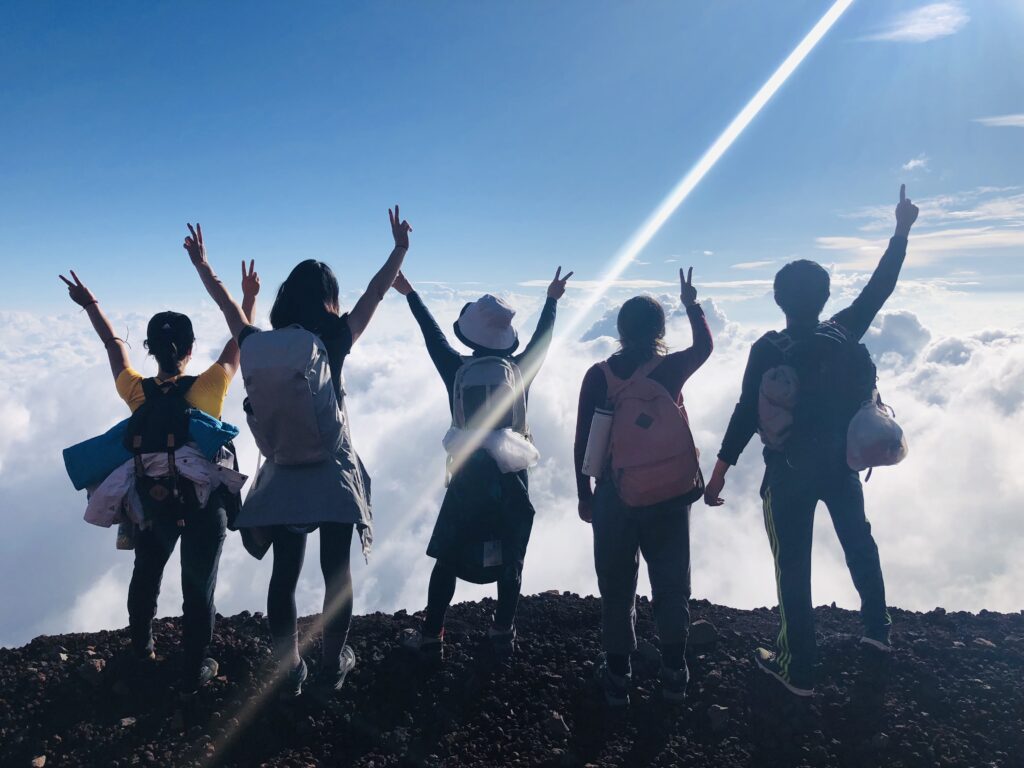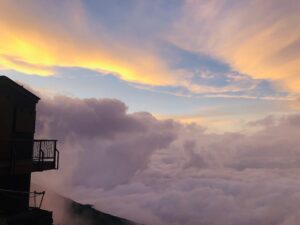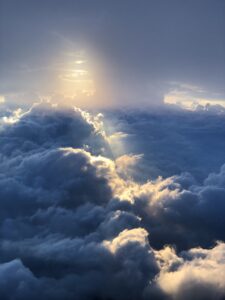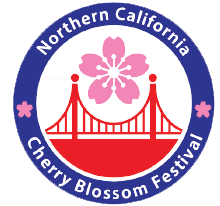A Beginner’s Guide

by Yuki Nishimura
In the early summer days of 2018, my friends and I were making plans for our Japan trip scheduled for later that summer. One of my more adventurous friends proposed summiting Mount Fuji, but another in my group felt apprehensive about climbing a mountain because it was something she had never done before. I reassured her that Mount Fuji is known to be a beginner-friendly mountain and that out of the four possible trails–Yoshida trail, Subashiri trail, Gotemba trail and Fujinomiya trail–we had specifically chosen the “easiest†Yoshida trail.

On Mountain Day August 11th, five of us took a bus from Kawaguchiko Station to Fuji Subaru Line 5th Station, right where the Yoshida trail begins. We had not planned for our visit to Mount Fuji to be on Mountain Day–rather, it was something we found out while eavesdropping on the conversations of the hikers in the packed bus. Due to a confluence of planning mishaps, we began our ascent late in the afternoon with a heavy fog over our trail. When we had finally arrived at our hut, it was already 6PM and our hot curry dinner was a welcome sight to behold. As we ate, the staff informed us that the mountain was more crowded due to the holiday, and our group would need to be ready to leave for our night climb by 10PM if we wanted to catch the sunrise. (On any other day, waking up at midnight or even a little later would have been fine.) The prospect of less than three hours of sleep with some of us already exhibiting symptoms of mild altitude sickness dampened our mood a little, but the nap helped us recover and we resumed our climb.
Though many who climb Mount Fuji say the sunrise is the best part, I believe the best part is the night climb. All you can see above and below you is a zigzagging procession of headlamps. During one of the longer breaks, the five of us sat in astonishment as we saw a thunderstorm rumbling in the distance, with streaks of lightning flashing from the clouds below us. We also happened to be climbing on a night of a meteor shower so we lay down flat on the ground watching the endless stream of shooting stars on the night’s canvas.

All I can remember about the summit was the freezing cold. We sheltered for as long as we could in a little shack that offered steaming cups of hot cocoa and snacks and as the sun began to rise, an intrusive army of clouds partially obscured the view. It was unfortunate, but as we began our descent, the skies cleared up to show a brilliant and almost ethereal view of the sun pillowed amongst the clouds. When we finally returned back to base, I was exhausted but filled with a sense of accomplishment.
As I reflect back on this experience, there were several things I wish we had known or been more aware of prior to beginning our climb. Although Mount Fuji is unfortunately closed to the public due to the pandemic this year, I hope that future beginner climbers can someday find this useful.
1. Book your mountain huts early
The climbing season is from early July to mid-September. Bookings for mountain huts begin on April 1st every year–usually, via phone (they can speak English) or online (very limited huts have this option). Reservations fill up very fast, especially on popular holiday weekends. Remember also to check that the hut you choose is on the trail you decide to take. In our case, we stayed at a mountain hut on the Yoshida trail on the 7th station but there are huts available on the 8th station for those of you who would like to climb a shorter route at night. I recommend the “with dinner†option because it will do away with having to pack an extra meal and your meal will be nice and hot for when you arrive.
There is also an option of climbing Mount Fuji without sleeping in the huts (camping is prohibited so you will need to climb it all at once). However, I strongly recommend the overnight approach to climbing Mount Fuji, especially for beginners because it allows time to rest and acclimate to the high altitudes. Two of my friends who had symptoms of altitude sickness were able to recover thanks to the sleep they got in the huts.
Pro tip: Ask the staff what time they recommend you leave to catch the sunrise–they know how crowded the trail is and are the best source of real-time information on weather conditions at the summit.
2. Bring coins for the bathroom
In order to use the bathrooms during your climb, you will need to pay anywhere from 100-300 yen so do not forget to bring your coins. These fees help with the high cost of upkeep. Even if you stay in the mountain huts, many of them will still ask that you pay a fee to use the bathroom.
Pro tip: Use the bathroom before you reach the summit! The summit bathrooms are crowded and it will not be a pleasant experience freezing in line as you wait to use it.
3. Pack smartly
Leave behind any unnecessary items in a coin locker or have the hotel that you were (or will be) staying at hold it for you. Do not try to find a coin locker at Fuji Subaru Line 5th Station, because it is usually full and much more expensive than other places. I will not try to list all the items you should pack, but consider these recommendations:
- Headlamps
We realized on our way there that we do not have headlamps and ended up wasting time and money on buying three headlamps to share amongst the five of us. Critical mistake. Make sure to have your own as you will be climbing in dark conditions and the trail can suddenly get bumpy and precipitous.
- Eye mask and earplugs
If you plan on staying in the huts, these items will help you maximize your sleep time because the huts are shared sleeping quarters.
- Body wipes
They are very popular in Japan and you can get them most anywhere. Because you will be sweating quite a lot during your hike up and there will be no showers available, body wipes are the best alternative.
Pro tip: Pack all of your items in as compact a backpack as you can find. In my case, I used a 30-liter backpack. This made sure that I was packing only the essentials and helped me keep my balance when crawling up some rocky paths.
4. It will be bone-chilling cold
I kept telling my friends that it will be freezing up there and yet still, nothing could have prepared us for just how cold it was going to be up at the summit and in the early morning hours. Bring warm clothing that you can layer on top of your regular hiking clothing because during the day, it will be very hot and sweaty so you’ll want to be prepared for both weather conditions. Pack a winter coat that is water-resistant, gloves, thermal leggings and heavy-duty socks.
Pro tip: Once at the summit, try going into one of the restaurant shacks and drink something warm. They let you shelter from the cold as long as you have something you’re eating or drinking and it will be worth every yen.
5. Take your time climbing up
Many obaachans and ojiichans passed by our young group of 20-somethings. They would tell us “ganbare†as we struggled and sometimes crawled our way up. Our group quickly learned that the best way for all of us to make it to the top was to take our time and pace ourselves. Take plenty of breaks and walk slowly and carefully, as this will not only help prevent injuries but also allows time to acclimate.
Pro tip: If you want people behind you to climb ahead of you, try saying “osakini douzo†(ãŠå…ˆã«ã©ã†ãž), which is “please go ahead†in Japanese.
This post is part of a new series of introducing different aspects of Japanese and Japanese American experiences in the Bay Area and Japan.
Mountain Day (å±±ã®æ—¥, Yama no Hi) is a public holiday in Japan to celebrate the country’s mountains. In fact, almost 75% of Japan’s landmass consists of mountains, the most iconic being Mount Fuji. This holiday is usually on August 11th, as the kanji for the eighth month (å…«) resembles a mountain, and 11 signifies either a mountain top or two trees. This year, the holiday was scheduled a day early so the residents may enjoy a three-day weekend outside.
About the author:
Yuki Nishimura is from Palo Alto, California. She is a member of the Northern California Naginata Federation and a volunteer with the NCCBF PR/Marketing group.
